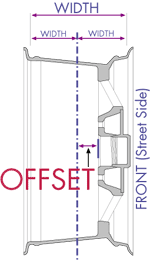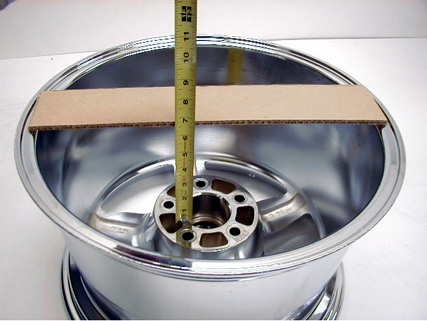Offsets and Backspacing
Posted by Tire & Wheel specialist...Pam on Feb 22nd 2017
Two of the most commonly unknown aspects when buying a new set of wheels are the offset and backspacing measurements.
What does
offset mean?
The offset of a wheel is the distance between
the center line of the wheel and the hub mounting surface. A positive offset
means that the hub mounting surface is closer to the outside edge. A negative
offset means that the hub mounting surface is closer to the inside edge. An
improper offset can cause the tire to rub against the outside fender or inside
fender well.
Zero Offset
The hub mounting surface is even with the centerline of the wheel.
Positive
The hub mounting surface is located in the front half of the wheel closer to the wheel face. This tucks the entire wheel in toward the brakes and vehicle suspension. Positive offset wheels are generally found on front-wheel drive cars and newer rear-wheel drive cars.
Negative
The hub mounting surface is located in the back half of the wheel closer to the back lip flange. This moves the wheel out away from the vehicle brakes and suspension. "Deep dish" wheels and wheels for lifted trucks are typically a negative offset.
If the offset of the wheel is not correct for the car, the handling can be adversely affected. Often, when changing the width of the wheel, the offset will also need to change to maintain proper clearances inside the wheel well. If the offset were to stay the same while you added width, the additional width would be split evenly between the inside and outside. For most cars, this won't work correctly. We test fit thousands of different vehicle and wheel size combinations to confirm which ones work correctly. Our extensive database allows our sales staff to offer you the perfect fit for your vehicle.
What is the backspacing on a wheel?
Hub Diameter or center bore is the hole at the center of the wheel. Rear spacing or back spacing is the distance from the backside of the wheel mounting pad to the outside of the rim flange.
The back spacing measurement is critical in the fitment of the wheel (and tire) to the vehicle. Since the suspension, brake, steering, and drive systems are typically located behind the wheel, the back spacing is used to define a volume behind the wheel where these items can exist.
The easiest way to measure backspace is to:
- Lay the wheel face down onto the ground so the backside of the wheel is facing up.
- Take a straight edge and lay it diagonally across the inboard flange of the wheel.
- Take a tape measure and measure the distance from where the straight edge contacts the inboard flange to the hub mounting pad of the wheel.
|






















